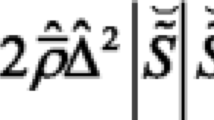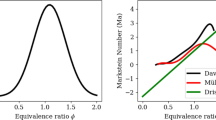Abstract
In this paper, the so-called REDIM–DTF sub-grid scale combustion model is proposed to improve the well-known dynamically thickened flame (DTF) combustion model by combining the DTF modeling strategy with the reaction-diffusion manifold (REDIM) chemistry table, which is generated from a detailed reaction mechanism. The new model is then used to calculate two lean premixed swirling flames in the PRECCINSTA combustor via large eddy simulation. The radial profiles of velocity, temperature, and species concentration, as well as the flame surface area and vortex structure are analyzed. The results are in good overall agreement with the corresponding experiment, and the performance of the REDIM–DTF model is very similar to that of the DTF model. The predicted CO mass fraction profiles, however, show a relatively larger discrepancy between the original DTF model and the proposed REDIM–DTF model, which is thought to be due to different reaction mechanisms used. As a smaller number of species transport equations are solved in the REDIM–DTF model, its computational efficiency is about 15% higher than that of the original DTF model.












Similar content being viewed by others
REFERENCES
C. Fureby, “Towards the use of Large Eddy Simulation in Engineering," Prog. Aerosp. Sci. 44 (6), 381–396 (2008); https:// doi.org/10.1016/j.paerosci.2008.07.003.
H. Pitsch, “Large-Eddy Simulation of Turbulent Reacting Flows," Prog. Aerosp. Sci. 44 (6), 466–478 (2008); https://doi.org/10.1016/j.paerosci.2008.06.005.
L. Y. M. Gicquel, G. Staffelbach, and T. Poinsot, “Large Eddy Simulations of Gaseous Flames in Gas Turbine Combustion Chambers," Prog. Energy Combust. 38 (6), 782–817 (2012); https://doi.org/10.1016/j.pecs.2012.04.004.
E. R. Hawkes and R. S. Cant, “A Flame Surface Density Approach to Large-Eddy Simulation of Premixed Turbulent Combustion," Proc. Combust. Inst. 28 (1), 51–58 (2000); https://doi.org/10.1016/S0082-0784(00)80194-0.
H. Pitsch, “A Consistent Level Set Formulation for Large-Eddy Simulation of Premixed Turbulent Combustion," Combust. Flame143 (4), 587–598 (2005); https://doi.org/10.1016/j.combustflame.2005.08.031.
O. Colin, F. Ducros, D. Veynante, and T. Poinsot, “A Thickened Flame Model for Large Eddy Simulations of Turbulent Premixed Combustion," Phys. Fluids 12 (7), 1843–1863 (2000); https://doi.org/10.1063/1.870436.
F. Charlette, C. Meneveau, and D. Veynante, “A Power-Law Flame Wrinkling Model for LES of Premixed Turbulent Combustion. Part I: Non-Dynamic Formulation and Initial Tests," Combust. Flame131 (1/2), 159–180 (2002); https://doi.org/10.1016/S0010-2180(02)00400-5.
P. Wang, J. Fröhlich, U. Maas, et al., “A Detailed Comparison of Two Sub-Grid Scale Combustion Models Via Large Eddy Simulation of the PRECCINSTA Gas Turbine Model Combustor," Combust. Flame164, 329–345 (2016); https:// doi.org/10.1016/j.combustflame.2015.11.031.
P. A. Strakey and G. Eggenspieler, “Development and Validation of a Thickened Flame Modeling Approach for Large Eddy Simulation of Premixed Combustion," J. Eng. Gas Turbines Power 132(7), 071501 (2010); https:// doi.org/10.1115/1.4000119.
M. T. Shang, W. P. Zhang, K. Zhang, and J. R. Fan, “Three-Dimensional Full Compressible Large-Eddy Simulation of Non-Premixed Combustion using Dynamically Thickened Flame Model," J. Combust. Sci. Technol. 16 (6), 496–502 (2010).
B. Franzelli, E. Riber, L. Y. M. Gicquel, and T. Poinsot, “Large Eddy Simulation of Combustion Instabilities in a Lean Partially Premixed Swirled Flame," Combust. Flame 159 (2), 621–637 (2012); https:// doi.org/10.1016/j.combustflame.2011.08.004.
M. Boileau, G. Staffelbach, B. Cuenot, et al., “LES of an Ignition Sequence in a Gas Turbine Engine," Combust. Flame154 (1/2), 2–22 (2008); https://doi.org/10.1016/j.combustflame.2008.02.006.
G. Boudier, L. Y. M. Gicquel, and T. J. Poinsot, “Effect of Mesh Resolution on Large Eddy Simulation of Reacting Flows in Complex Geometry Combustors," Combust. Flame 155 (1), 196–214 (2008); https:// doi.org/10.1016/j.combustflame.2008.04.013.
P. Schmitt, T. Poinsot, B. Schuermans, and K. P. Geigle, “Large-Eddy Simulation and Experimental Study of Heat Transfer, Nitric Oxide Emissions and Combustion Instability in a Swirled Turbulent High-Pressure Burner," J. Fluid Mech. 570, 17–46 (2007); https:// doi.org/10.1017/S0022112006003156.
O. Gicquel, N. Darabiha, and D. Thévenin, “Liminar Premixed Hydrogen/Air Counterflow Flame Simulations using Flame Prolongation of ILDM with Differential Diffusion," Proc. Combust. Inst.28 (2), 1901–1908 (2000); https://doi.org/10.1016/S0082-0784(00)80594-9.
P. D. Nguyen, L. Vervisch, V. Subramanian, and P. Domingo, “Multidimensional Flamelet-Generated Manifolds for Partially Premixed Combustion," Combust. Flame 157 (1), 43–61 (2010); https:// doi.org/10.1016/j.combustflame.2009.07.008.
U. Maas and S. B. Pope, “Simplifying Chemical Kinetics: Intrinsic Low-Dimensional Manifolds in Composition Space," Combust. Flame88, 239–264 (1992); https://doi.org/10.1016/0010-2180(92)90034-M.
V. Bykov and U. Maas, “Problem Adapted Reduced Models Based on Reaction-Diffusion Manifolds (REDIMs)," Proc. Combust. Inst.32, 561–568 (2009); https://doi.org/10.1016/j.proci.2008.06.186.
W. Meier, P. Weigand, X. R. Duan, and R. Giezendanner-Thoben, “Detailed Characterization of the Dynamics of Thermoacoustic Pulsations in a Lean Premixed Swirl Flame," Combust. Flame150, 2–26 (2007); https://doi.org/ 10.1016/j.combustflame.2007.04.002.
T. D. Butler and P. J. O’Rourke, “A Numerical Method for Two-Dimensional Unsteady Reacting Flows," Proc. Combust. Inst.16, 1503–1515 (1977); https://doi.org/10.1016/S0082-0784(77)80432-3.
J. P. Légier, T. Poinsot, and D. Veynante, “Dynamically Thickened Flame LES Model for Premixed and Non-Premixed Turbulent Combustion," in Proc. of Summer Program, Center for Turbulent Research (Stanford University, 2000), pp. 157–168.
L. Selle, G. Lartigue, T. Poinsot, et al., “Compressible Large Eddy Simulation of Turbulent Combustion in Complex Geometry on Unstructured Meshes," Combust. Flame 137, 489–505 (2004); https://doi.org/10.1016/j.combustflame.2004.03.008.
M. Kuznetsov, R. Redlinger, W. Breitung, et al., “Laminar Burning Velocities of Hydrogen–Oxygen-Steam Mixtures at Elevated Temperatures and Pressures," Proc. Combust. Inst. 33, 895–903 (2011); https:// doi.org/10.1016/j.proci.2010.06.050.
G. P. Smith, D. M. Golden, M. Frenklach, et al., GRI-Mech 3.0 (1999); http://www.me.berkeley.edu/ gri_mech/version30/text30.html.
G. Steinhilber and U. Maas, “Reaction-Diffusion Manifolds for Unconfined, Lean Premixed, Piloted, Turbulent Methane/Air Systems," Proc. Combust. Inst. 34 (1), 217–224 (2013); https://doi.org/ 10.1016/j.proci.2012.06.164.
B. Fiorina, D. Veynante, and S. Candel, “Modeling Combustion Chemistry in Large Eddy Simulation of Turbulent Flames," Flow Turb. Combust. 94 (1), 3–42 (2015); https://doi.org/10.1007/s10494-014-9579-8.
P. Wang, N. A. Platova, J. Fröhlich, and U. Maas, “Large Eddy Simulation of the PRECCINSTA Burner," Int. J. Heat Mass Transf.70, 486–495 (2014); https://doi.org/10.1016/j.ijheatmasstransfer.2013.11.025.
J. Zhu, “A Low-Diffusive and Oscillation-Free Convection Scheme," Commun. Appl. Numer. Methods 7, 225–232 (1991); https://doi.org/10.1002/cnm.1630070307.
P. Moin, K. Squires, W. Cabot, and S. Lee, “A Dynamic Subgrid-Scale Model for Compressible Turbulence and Scalar Transport," Phys. Fluids 3, 2746–2757 (1991); https://doi.org/10.1063/1.858164.
V. Moureau, P. Minot, H. Pitsch, and C. Bérat, “A Ghost-Fluid Method for Large-Eddy Simulations of Premixed Combustion in Complex Geometries," J. Comput. Phys. 221, 600–614 (2007); https://doi.org/10.1016/j.jcp.2006.06.031.
J. Galpin, A. Naudin, L. Vervisch, et al., “Large-Eddy Simulation of a Fuel-Lean Premixed Turbulent Swirl-Burner," Combust. Flame155 (1/2), 247–266 (2008); https://doi.org/10.1016/j.combustflame.2008.04.004.
B. Fiorina, R. Vicquelin, P. Auzillon, et al., “A Filtered Tabulated Chemistry Model for LES of Premixed Combustion," Combust. Flame 157, 465–475 (2010); https://doi.org/10.1016/j.combustflame.2009.09.015.
P. Wang, J. Fröhlich, and U. Maas, “LES of Turbulent Premixed Swirling Flames in Complex Geometry Using Thickened-Flame Type of Models," in Proc. of the 5th Eur. Combustion Meeting (Cardiff, UK, 2011), Paper 356.
J. Jeong and F. Hussain, “On the Identification of a Vortex," J. Fluid Mech. 332 (1), 339–363 (1995); https://doi.org/10.1017/S0022112095000462.
G. Steinhilber, V. Bykov, and U. Maas, “REDIM Reduced Modeling of Flame-Wall-Interactions: Quenching of a Premixed Methane/Air Flame at a Cold Inert Wall," Proc. Combust. Inst. 36 (1), 655–661 (2017); https://doi.org/10.1016/j.proci.2016.08.057.
S. Meares and A. R. Masri, “A Modified Piloted Burner for Stabilizing Turbulent Flames of Inhomogeneous Mixtures," Combust. Flame 161 (2), 484–495 (2014); https://doi.org/10.1016/j.combustflame.2013.09.016.
Author information
Authors and Affiliations
Corresponding author
Rights and permissions
About this article
Cite this article
He, HK., Wang, P., Xu, L. et al. Large Eddy Simulation of Lean Premixed Swirling Flames via Dynamically Thickened Flame Model Coupling with the REDIM Chemistry Table. Combust Explos Shock Waves 56, 634–647 (2020). https://doi.org/10.1134/S0010508220060039
Received:
Published:
Issue Date:
DOI: https://doi.org/10.1134/S0010508220060039




